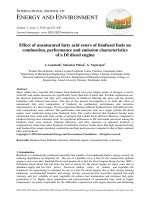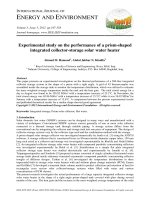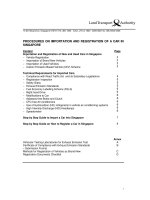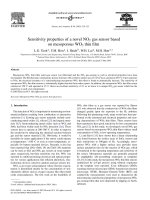Alexander skutin, on rotation of a isogonal point
Bạn đang xem bản rút gọn của tài liệu. Xem và tải ngay bản đầy đủ của tài liệu tại đây (170.75 KB, 2 trang )
ON ROTATION OF A ISOGONAL POINT
ALEXANDER SKUTIN
Abstract. In this short note we give a synthetic proof of the problem posed
by A. V Akopyan in [1]. We prove that if Poncelet rotation of triangle T
between circle and ellipse is given then the locus of the isogonal conjugate
point of any fixed point P with respect to T is a circle.
We will prove more general problem:
Problem. Let T be a Poncelet triangle rotated between external circle ω and
internal ellipse with foci Q and Q
and P be any point. Then the locus of points P
isogonal conjugates to P with respect to T is a circle.
Proof. First, prove the following lemma:
Lemma. Suppose that ABC is a triangle and P , P
and Q, Q
are two pairs of
isogonal conjugates with respect to ABC. Let H be a Miquel point of lines P Q,
P Q
, P
Q and P
Q
. Then H lies on (ABC).
A B
C
P
P
Q
Q
Q
Q
Q
Q
Q
Q
Q
Q
Q
Q
Q
Q
Q
Q
Q
Q
Q
Q
Q
Q
Q
Q
Q
Q
Q
Q
Q
Q
Q
Q
Q
Q
Q
Q
Q
Q
Q
Q
Q
Q
Q
Q
Q
Q
Q
Q
Q
Q
Q
Q
Q
Q
Q
Q
Q
Q
Q
Q
Q
Q
Q
Q
Q
Q
H
Fig. 1.
H
P
P
P
P
P
P
P
P
P
P
P
P
P
P
P
P
P
P
P
P
P
P
P
P
P
P
P
P
P
P
P
P
P
P
P
P
P
P
P
P
P
P
P
P
P
P
P
P
P
P
P
P
P
P
P
P
P
P
P
P
P
P
P
P
P
Q
P
Q
Q
Q
Q
Q
Q
Q
Q
Q
Q
Q
Q
Q
Q
Q
Q
Q
Q
Q
Q
Q
Q
Q
Q
Q
Q
Q
Q
Q
Q
Q
Q
Q
Q
Q
Q
Q
Q
Q
Q
Q
Q
Q
Q
Q
Q
Q
Q
Q
Q
Q
Q
Q
Q
Q
Q
Q
Q
Q
Q
Q
Q
Q
Q
Q
Fig. 2.
Proof. From here, the circumcircle of a triangle XY Z is denoted by (XY Z) and
the oriented angle between lines and m is denoted by ∠(, m). Let A
∗
and B
∗
be
such points that A
∗
AH ∼ B
∗
BH ∼ P QH. It is clear that HP Q ∼ HQ
P
. From
construction it immediately follows that there exists a similarity with center H
which maps the triangle QBP
to the triangle P B
∗
Q
. So HP B
∗
Q
∼ HQBP
,
and similarly A
∗
P Q
H ∼ AQP
H. From the properties of isogonal conjugation
it can be easily seen that ∠(Q
A
∗
, A
∗
P ) = ∠(P
A, AQ) = ∠(Q
A, AP ), hence
66
REFERENCES 67
points A
∗
, A, P , and Q
are cocyclic. Similarly the quadrilateral P B
∗
BQ
is
inscribed in a circle. Let lines AA
∗
and BB
∗
intersect in a point F . Indeed
ABQH ∼ A
∗
B
∗
P H, so ∠(BQ, QA) = ∠(B
∗
P, P A
∗
). Obviously ∠(B
∗
P, P A
∗
) =
∠(B
∗
B, BQ
) + ∠(Q
A, AF ). Thus
∠(B
∗
P, P A
∗
) + ∠(BQ
, Q
A) =
= ∠(F B, BQ
) + ∠(BQ
, Q
A) + ∠(Q
A, AF ) = ∠(BF, F A),
but we have proved that
∠(B
∗
P, P A
∗
) + ∠(BQ
, Q
A) = ∠(BQ, QA) + ∠(BQ
, Q
A) = ∠(AC, CB),
so F is on (ABC). We know that A
∗
AH ∼ B
∗
BH, so ∠(A
∗
A, AH) = ∠(B
∗
B, BH),
hence AF HB is inscribed in a circle. From that it is clear that H is on (ABC).
Now the problem can be reformulated in the following way. Suppose that ω
is a circle, P , Q and Q
are fixed points, H is a variable point on ω . Let P
be
such a point that P QH ∼ Q
P
H. We need to prove that locus of points P
is a
circle.
It is clear that the transformation which maps H to P
is a composition of an
inversion, a parallel transform and rotations. Indeed, denote by z
x
the coordinate
of a point X in the complex plane. Than this transformation have the following
equation:
z
h
→ z
q
+ (z
h
− z
q
)
z
q
− z
p
z
h
− z
p
.
Therefore, the image of the circle ω under this transformation is a circle.
Author is grateful to Alexey Pakharev for help in preparation of this text.
References
[1] A. V. Akopyan. Rotation of isogonal point. Journal of classical geometry:74,
1, 2012.
Moscow State University
E-mail address:









